There are lots of night sky objects to see with a small telescope, but often, beginners will find it difficult to decide what to look for and where to find them. This guide will go into some of the best Deep Sky Objects to see in the northern skies. (Though I will mention in passing a few comparable southern objects as well.)
Content in this article:
What To Expect When Viewing DSOs
Deep-sky objects are any objects that are made of multiple stars and are beyond our solar system. They’re usually extended objects, taking up a wider field of view than the pinpricks of starlight, and they take many different forms, ranging from balls of stars to tenuous glowing plasma.
For the experienced amateur astronomer, viewing deep-sky objects can be some of the most beautiful and rewarding experiences at the eyepiece. However, many beginner astronomers find disappointment and confusion when looking for nebulae. This is largely down to expectations. Nowadays, we see very beautiful pictures of nebulae, star clusters, and galaxies, but these are produced with research-grade telescopes using long exposure times and a lot of processing to bring out unnatural but scientifically useful colors. The amateur astronomer doesn’t have anything like that. We have small telescopes, usually no bigger than 8” (and often as small as 2”) in aperture, so we can’t grab huge amounts of light, and our brains won’t let us take long exposures with our eyes.
Some amateur astronomers prefer to use cameras to take long exposures, and that’s their prerogative. However, that is an incredibly technical and expensive hobby that is not at all suited for the beginner, and it really does not match the simple pleasures of peering through our eyepiece as if it were a window into the cosmos. There are a few tricks we can use to improve our viewing conditions for dim extended objects, to go from faint fuzzy to beautiful nebulosity.
- Get a Larger Telescope: A larger telescope aperture will take in more light to focus on the eyepiece, and so it should be no surprise that bigger is better and brighter. But this is only helpful advice if you’re in the market to buy a new telescope. Still, if you are buying a telescope, the best choice for deep sky observing is the largest Dobsonian you can afford and carry. However, most of the objects on this list can be seen with binoculars or a small telescope of 2”-4” aperture, and detail can be resolved with a 6” telescope.
- Go to darker skies: If you’re observing in a city, you’ll be able to see only pale ghosts of the brightest deep sky objects, no matter how big your telescope is. Suburban light pollution can still be an issue, but much less so. If you can drive your telescope out to a rural, dark site, you’ll get the best views your telescope can provide. If you must observe from a light-polluted home, do your best to find a location where no streetlights or security lights are shining directly on you. Observe DSOs when the Moon is not bright.
- Point to darkest part: Determine which part of your sky is the darkest. If you have a major city to the west, there is likely a bright light dome in that direction. Your darker location will be away from that light dome, and you will have greater success finding and viewing your targets. Focus your observation on the darker part of your sky.
- Use a Red Light: Never shine a white light or use a bright white phone screen. Red light preserves night vision better than any other color, so if you must shine a light at night to see what you’re doing, make sure it’s a dim red flashlight.
- Keep an Observing Log: In addition to all the other good reasons to keep an observing log, sketching the things you see at the eyepiece is one of the best. You may be surprised at how much of a difference is made by training your brain to see subtle, dim detail, which is best learned by trying to reproduce whatever detail you can see accurately into a sketch in your log. You can also compare different eyepieces, telescopes, and viewing conditions to see how they change the clarity of your view.
- Use Averted Vision: The light-sensitive cells in your retina are most sensitive to dim light at the edges of your vision. So when you have a dim object centered in your eyepiece, dart your eyes around or point your eyes towards the edge of the field of view, but focus your attention on the center, where the object is. This trick is one of the most important and can make the difference between seeing nothing but a faint blob and seeing subtle details in an object.
- Use a Higher Power: It’s usually a good idea to search for objects in a wide-field-of-view, low-magnification eyepiece. However, some objects with low surface brightness actually pop out better when you use a higher magnification and make the background sky darker. Too high, though, and the field of view is too small to find the object. When you find an object, be sure to try it at multiple magnifications to see which is best.
- Start with Low Magnitude Objects: When you look at a chart or one of the computer/phone apps, you will see that deep sky objects are rated by a scale called magnitude. In simple terms, the lower the number, the brighter the object.
- Select Higher Objects: Select targets that are higher in the sky, say above 30 degrees altitude. As you look closer to the horizon, you have to deal with more light pollution and more atmosphere. This reduces the quality of the image you will see. Typically, the higher you go in the sky, the better the image, as you are looking through less atmosphere.
10 Top Deep Space Objects for Binoculars and Small Telescopes
10. Beta Cygni: Albireo
- Object Type: Double Star
- Magnitude: +2.9
- Angular Separation: 35 arcseconds
- Best Seen in the Evening: Summer and Fall
- Best Magnification: Medium or High
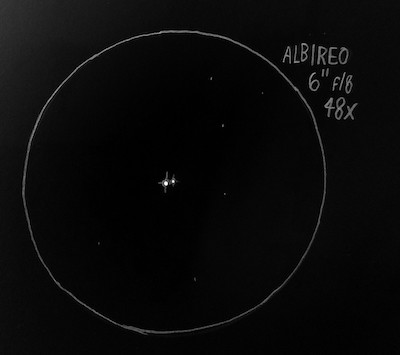
Albireo is one of the best double stars to view with an amateur telescope. Even a small one can make out the pair of stars seen in the rich starfields of Cygnus. Finding it is easy. Find the summer triangle, a wide grouping of stars made up of Vega, Altair, and Deneb. About halfway between Vega and Altair, and then a little bit upwards towards Deneb, is Albireo. It’s easily seen along with the other stars making up The Swan or The Summer Cross in dark skies, but you might struggle to pick it out in bright suburbs or a city. There are many more double stars worth looking at, but Alberio is probably the best.
It appears as two stars, one of considerably greater brightness than the other. There’s also a significant color difference, but I prefer not to spoil it!
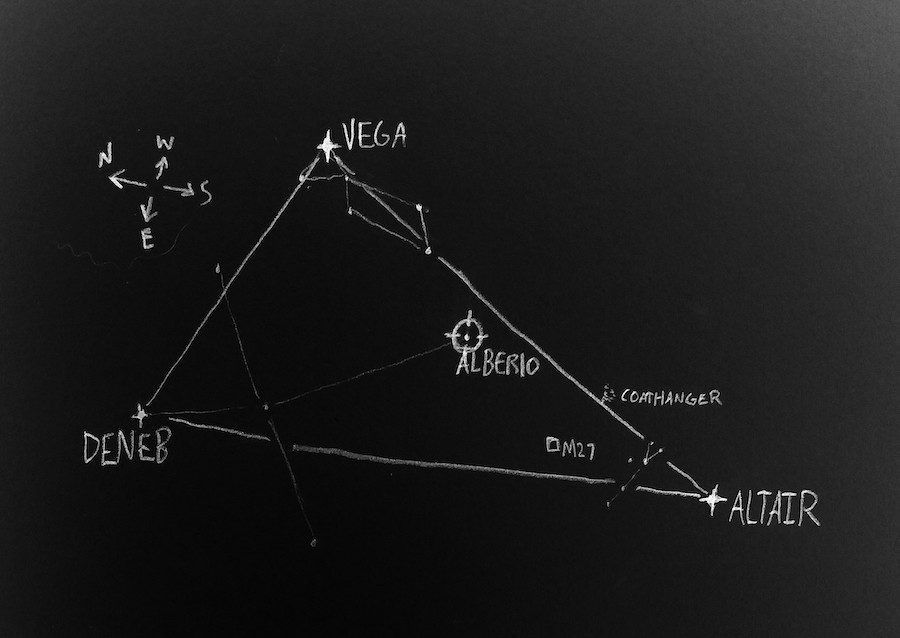
9. Messier 8: The Lagoon Nebula & NGC 6530 Cluster
- Object Type: Emission Nebula & Open Cluster
- Magnitude: +6.0 & +4.6.
- Angular Size: Approx. 14 Arcminutes
- Best Seen in the Evening: Summer
- Best Magnification: Low or Medium
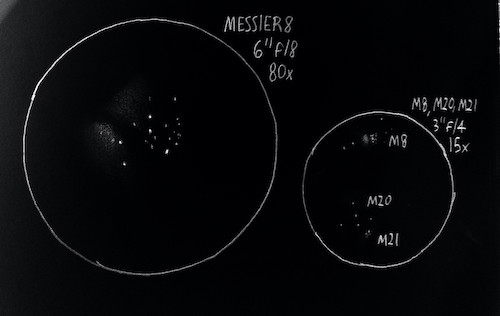
Messier 8 is one of the many jewels you may find scanning around the constellation Sagittarius with a telescope. It lies in the direction of the center of the galaxy, in a quite populated neighborhood. In a large telescope in suburban skies, it shows a bean-shaped nebula, and averted vision reveals wider nebulosity surrounding the region, with a dark lane—the “lagoon”—running through the space between the bean-shaped nebula and the open cluster, NGC 6530. The open cluster is brighter, and you’ll likely see it as a blurry starry region in your finderscope.
M8 is not difficult to find; simply search around for a puff of smoke above the teapot. To the North of M8 are another couple of Messier objects: M20, the Trifid Nebula (a small double star with a faint circular blob around it from suburban and rural skies), and M21, a small open star cluster. Also, don’t miss the Swan Nebula M17, which is also in Sagittarius.

8. Messier 27: The Dumbbell Nebula
- Object Type: Planetary Nebula
- Magnitude: +7.5
- Angular Size: 8 arcminutes
- Best Seen in Evening: Summer and Fall
- Best Magnification: Low
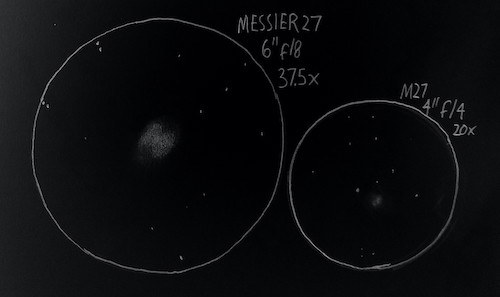
The Dumbbell Nebula is one of two notable Planetary Nebula (nebulae that, according to William Herschel, vaguely resemble the planet Uranus in their apparent size and greenish color) in Lyra. It is the expanding gas cloud of a dying sun-mass star that has shed its outer layers. At very low powers, it appears as a dim oval, but at medium-low powers, when the background of the sky is suitably dark—rural or suburban skies with no moon out—you can see it as a two-lobed (dumbbell) shape with a faint oval background. I was able to see it quite well at 16x in a 4” reflector.
It can be found by following a diagonal cross in The Arrow, Sagitta, five times the length of that cross, or by following the line from Vega to Albireo, as shown in the accompanying chart.
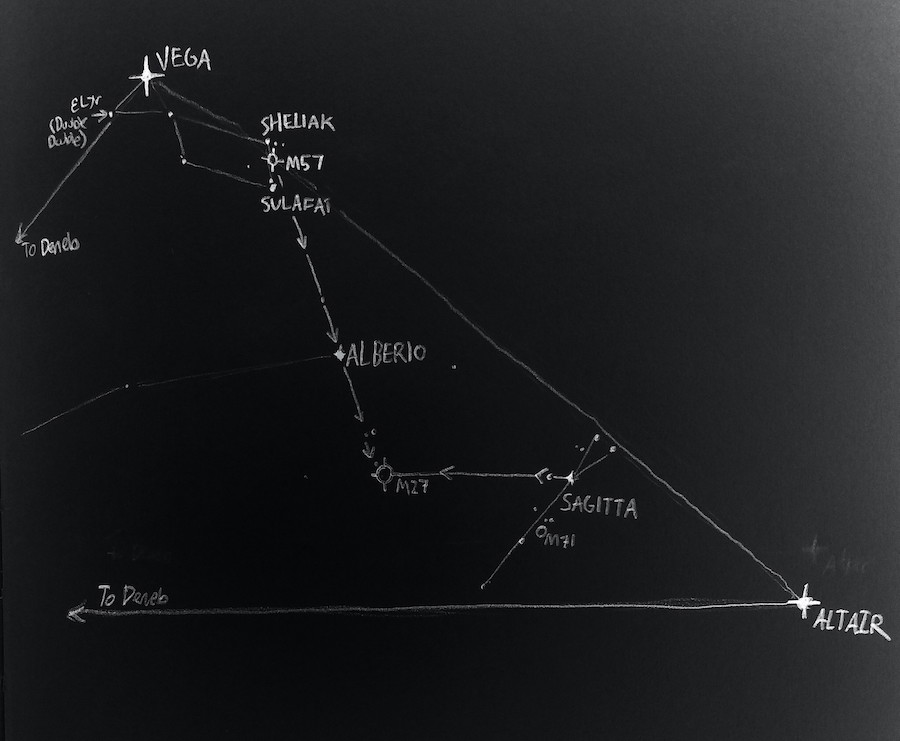
7. Messier 57: The Smoke Ring Nebula
- Object Type: Planetary Nebula
- Magnitude: +8.8
- Angular Size: 3.8 arcminutes
- Best Seen in the Evening: Summer and Fall
- Best Magnification: Medium or High
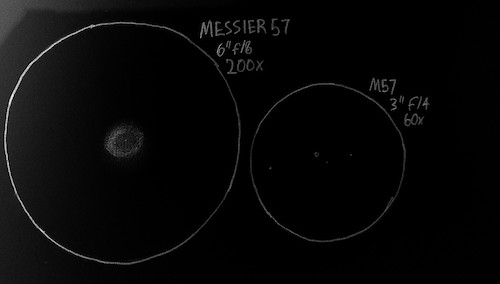
John Dobson once said a child called this the “Ghost of a Cheerio.” I like that; it’s very fitting. M57 has a greater surface brightness but a smaller apparent size than M27. At low power or in a finderscope, it is visible as a fuzzy dot between Sulafat & Sheliak, as seen in the accompanying map. A medium magnification reveals it to be a fuzzy disk distinct from a star. With medium-high power and either dark skies, or a telescope with an aperture of 6” or more, the ring shape is distinct and obvious. In rural skies and with a 6” or larger telescope, you might be able to see a distinct green color–something to pay attention for.
6. Messier 81 & Messier 82: The Double Galaxy
- Object Type: Two Spiral Galaxies
- Magnitudes: 6.94 & 8.41.
- Angular Size: 27 arcminutes & 11 arcminutes.
- Angular Separation: 31 arcminutes
- Best Seen in Evening: Spring (Circumpolar above 21°N latitude)
- Best Magnification: Low and Medium.
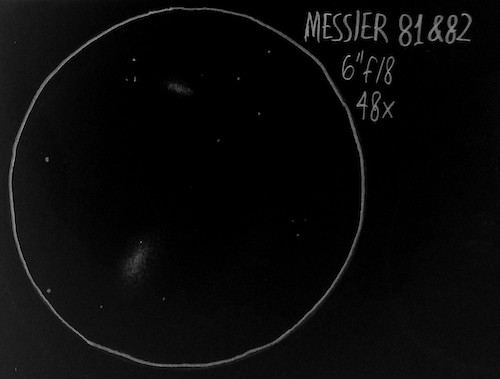
In a dark sky, these two galaxies are easily visible together with binoculars and a small telescope, though they become fairly tough in suburban skies. It took me a few nights of trying before I managed to find them with my 6” Dobsonian. They’re not too difficult to locate. Find the Big Dipper. If you follow the line between Phecda towards Dubhe and extend that by the same length again, you’ll be in the right neighborhood.
When you find them, you’ll see two blobs of light. With dark skies and an 8” telescope, you will be able to see subtle spiral structure in M81. The M82 is an edge-on galaxy and looks a bit like a cigar. It’s also a starburst galaxy with lots of active star formation, so there’s a subtle sparkle within it, which is just barely visible to me with my 6” telescope in dark suburbs.
Seeing two galaxies so close together like this is an impressive sight. The galaxies are in fact close in actual space as well as in the sky, and like the Andromeda Galaxy and our own Milky Way, the two are on a collision course.
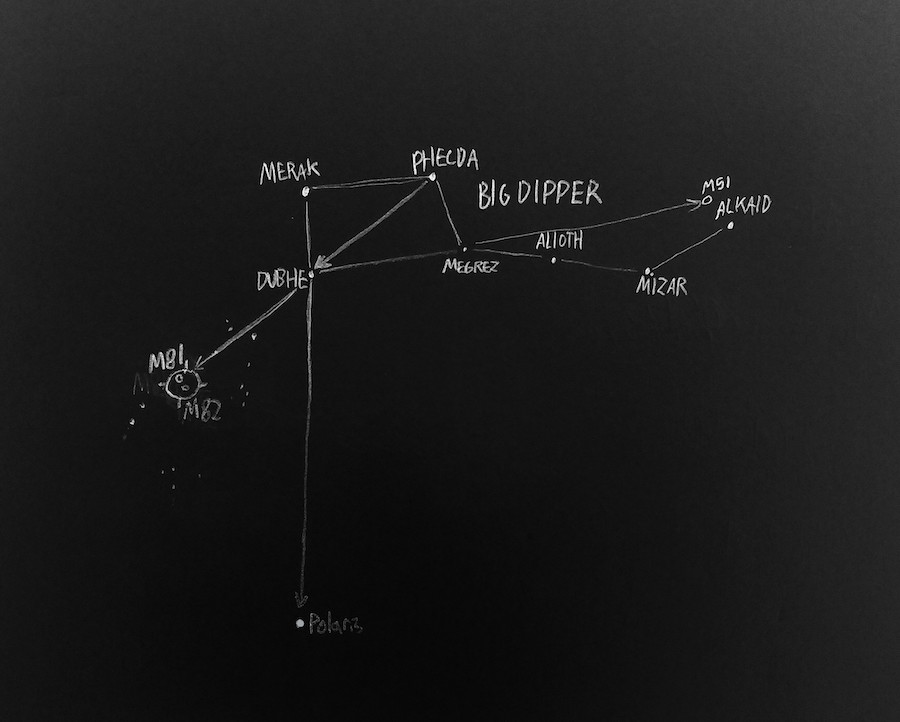
5. Messier 13: The Great Globular Cluster in Hercules
- Object Type: Globular Cluster
- Magnitude: +5.8
- Angular Size: 20 Arcminutes
- Best Seen in the Evening: Summer and Fall
- Best Magnification: Low, Medium, and Medium-High.
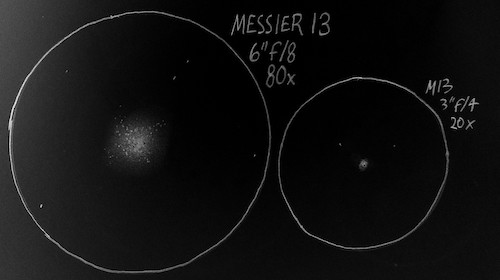
Messier 13 is the best globular cluster visible in the Northern Hemisphere. It is a ball of old, luminous stars 22,000 light-years away and 84 light-years across. In every telescope I’ve used to look for it, big and small, when it enters the field of view, it really pops out. When seen with a small telescope, it is a large fuzzy blob that is clearly distinct from the stars. In a middle-sized or larger telescope, it is possible to see individual stars as granularity in the cluster, giving it the appearance of a pile of sand. M13 is fairly structured, and with a dark sky and/or larger telescope, several patterns show up that hint at a square-ish or “x” shape.
M13 is fairly easy to find, being situated between two stars in the Keyhole of Hercules, as shown in the map.
Some other globulars worth looking for are Messier 4 (highly structured cluster, almost mistaken for a compact open cluster), M22 (A bright, slightly elliptical globular), and M3 (Halfway between Arcturus and Cor Caroli; the only good Spring Evening Globular)
If you’re in the Southern Hemisphere, don’t miss out on Omega Centauri & 47 Tuc. Both are excellent globular clusters that Northerners like myself are quite jealous of.
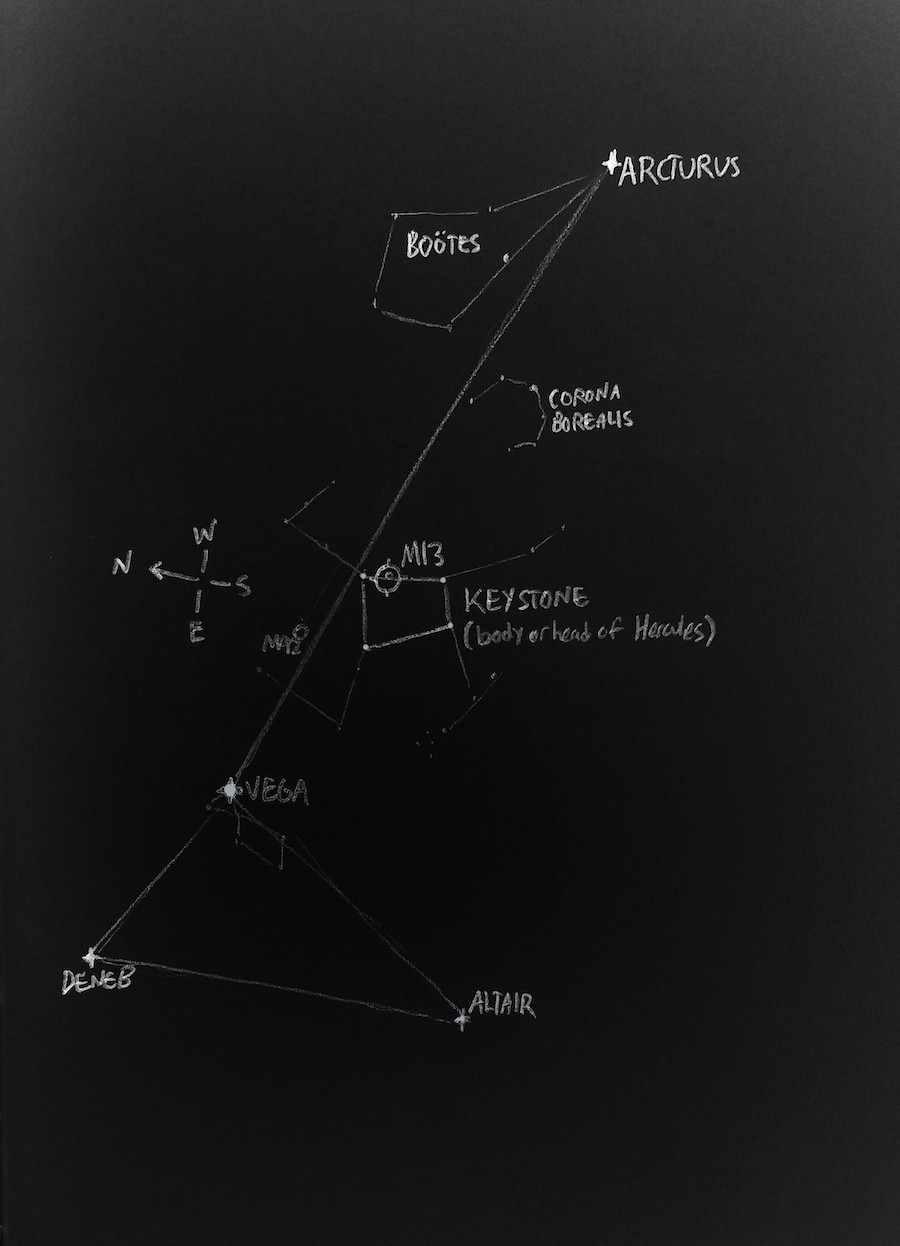
4. Messier 31: The Great Galaxy in Andromeda
- Object Type: Spiral Galaxy
- Magnitude: +3.4
- Angular Size: 3.167° × 1°
- Best Seen in the Evening: Fall and Winter
- Best Magnification: Low
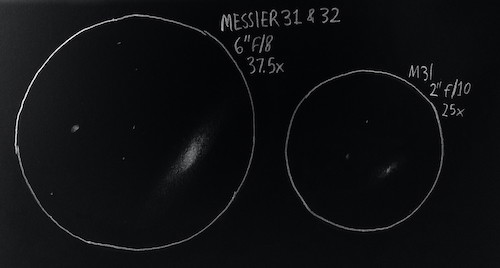
Oh, here it comes.
The Andromeda Galaxy is so popular that many don’t realize it’s named after the constellation it’s in. It is the nearest spiral galaxy to our own and is enormous in the sky. In dark skies when the Milky Way is visible, M31 is visible as a noticeable smudge nearby the Great Square of Pegasus. It can be found by following Andromeda’s body out of the Great Square or by following a triangle formed in the constellation Cassiopeia.
When you see the galaxy, you’re mostly looking at the core—the bright, highly populated region of older stars. This core is a little smaller than the Moon. In dark skies with a large telescope, the faint hint of the rest of the disk of the galaxy is visible as a dim, long, thin extension from the core. Look for the sharp cutoff of light on one side of that faint extension; that will be a dust lane in the galaxy blocking starlight.
With a small telescope, you should also be able to see Messier 32, a satellite galaxy of M31, as a faint blob that is almost mistaken for a nearby star.
The Andromeda Galaxy is easily visible with binoculars and telescopes of all sizes.
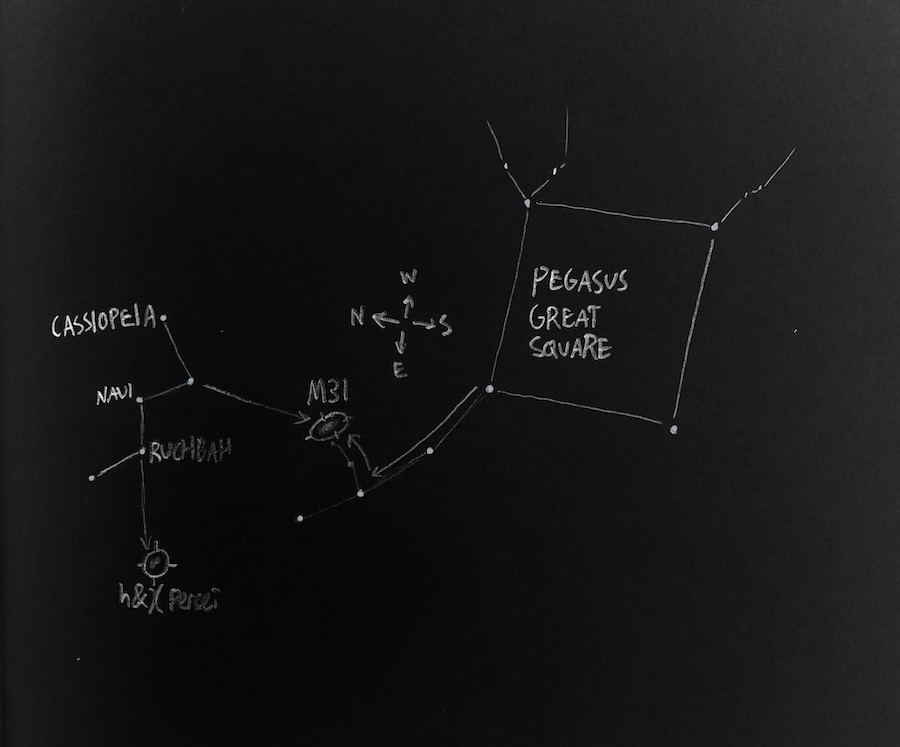
3. h & χ Persei: The Double Cluster in Perseus
- Object Type: Two Open Clusters
- Magnitude: +3.7 & +3.8
- Angular Size: 30 arcminutes & 30 arcminutes
- Angular Separation: 60 arcminutes
- Best Seen in the Evening: Fall and Winter
- Best Magnification: Low (both), Medium (individual)
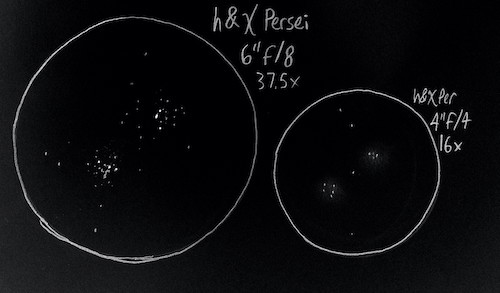
This is another object that is spectacular in a telescope and easily visible in binoculars. It is found by following the line from Navi to Ruchbah in Cassiopeia until you’re halfway from Ruchbah to Mirfak in Perseus. When seen in dark skies, it is unparalleled. Two large open clusters of stars (each of different distances, which happen to be in the line of sight) are visible as a pair of starfields with a large telescope, or two fuzzy blobs with a small telescope or binoculars. With a large telescope, take the time to study each cluster individually with medium power, appreciating the multitude of stars. Pay attention to the color of the stars, as there are a few red giants in and around the two clusters.
2. Messier 45: The Pleiades
- Object Type: Open Cluster
- Magnitude: +1.6
- Apparent Size: 110 arcminutes
- Best Seen: Late Fall through Early Spring
- Best Magnification: Low

The Pleiades, also known as Subaru, Seven Sisters, or Messier 45, is one of the best open clusters in the sky and is easily visible to the unaided eye in dark skies. According to legend, the ancient Romans would use the Pleiades to test the eyesight of their soldiers—if you can see seven stars, you have excellent eyesight. In suburban skies, it can take the form of a fuzzy ball of light seen with averted vision that disappears into one or two dim stars when observed directly.
Photographs of the Pleiades show the reflection nebula, a region of dust and gas that the Pleiades is currently traveling through. However, this is nearly impossible to view with your eye, and if you think you see it, it’s more likely your optics are dewing up.
Related: How to find Pleiades star cluster?
In a pair of binoculars or a small telescope, it is easy to take in the entirety of the cluster. You can see not just the seven brightest stars but also dozens of smaller ones. A large telescope is actually fairly difficult to use to observe the Pleiades because it is So Big. You’ll need low magnification and a wide field of view. I can just about fit the Pleiades into my 6” f=1200mm Dobsonian using a 32mm Plossl eyepiece. If you’re using your Dob’s stock 25mm Plossl, you might not be able to get it all at once. But it is spectacular with almost any telescope. Strings of stars are visibly sparkling around the bright main stars, and the bright stars really are bright.
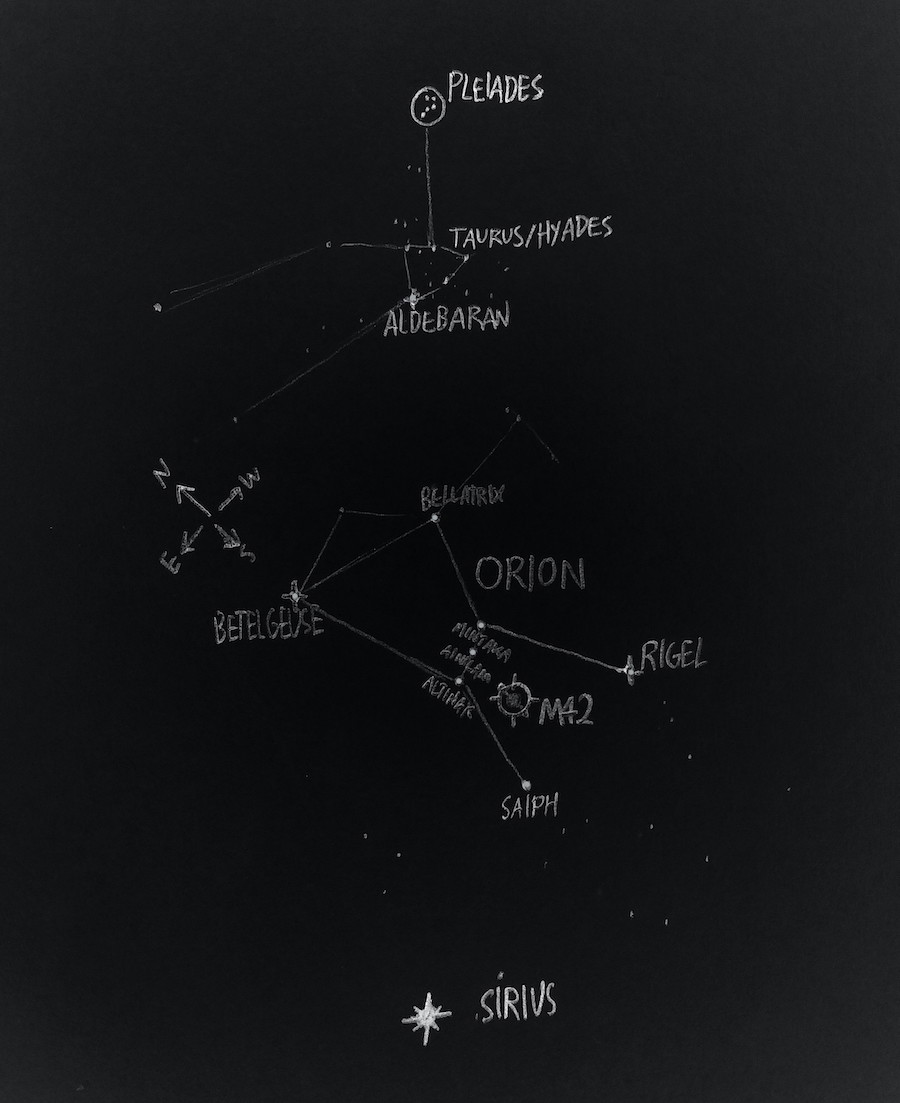
1. Messier 42: The Great Nebula in Orion & the Trapezium
- Object Type: Emission Nebula & Multiple Star/Minicluster.
- Magnitude: +4.0
- Apparent Size: 65 Arcminutes
- Best Seen: Late Fall through Early Spring
- Best Magnification: Low & Medium (Nebula), High (Trapezium)
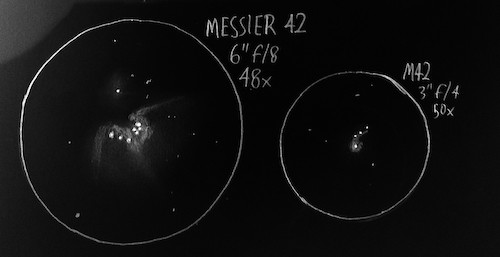
This is the single best and brightest nebula in the night sky as seen in the Northern Hemisphere. (Southerns should be sure to check out the Grand Nebula in Carina, which again provides plenty of jealousy among Northern Observers.)
M42, the Great Nebula, is easy to find even with a small telescope. Look under the belt of Orion for a string of stars called the Sword. This is a very beautiful and starry region seen through binoculars. In the center of the Sword is a special treat: a nebula that is easily seen with binoculars, even in suburban skies. Through a telescope, a vaguely boxy feature with an arm outstretched along three stars can be seen, with a bright star in the middle. At a high magnification in a telescope of around 4” or more, that feature is revealed to be the Trapezium, a small cluster of bright, hot stars. The brightest of these is an O-type ultrahot star, whose heat and ultraviolet light are responsible for powering the nebula. The Nebula is a star-forming region and will eventually form a star cluster similar to the Pleiades.
In dark skies and/or with a large telescope, especially with averted vision, fainter wings and rays of nebulosity seem to flow from the bright nebular core, and this is a truly spectacular sight.
Dim nebulosity M43 can be seen as a halo around a nearby star.
Three Runners Up:
Unfortunately, I don’t have room to write about every single Deep Sky Object and how to find it in great detail. But as we wind up, I would like to consider some objects that are nice but didn’t make the list because I don’t have good notes on them. They’re worth looking up and trying as well.
- Messier 44: Praesepe, The Beehive Cluster in Cancer. Best seen in spring and early summer. A large object, easily seen in binoculars as well. Needs a wide field of view to take in fully.
- Messier 11: The Wild Duck Cluster in Scutum. Best seen in Summer. Another object which is visible both in binoculars and telescopes.
- NGC 457: The “ET” Cluster or Owl Cluster in Cassiopeia. Interesting shape. Best seen in Fall and Winter, but circumpolar at some latitudes. Best in a Dobsonian, but bright enough to be worth chasing in a smaller scope as well.
…And More.
I have to stress that this is a subjective ranking, and there are doubtless many objects that can be seen in the night sky that I could have added to the list. I can highly recommend the book “Turn Left at Orion” by Guy Consolmagno and Dan M. Davis. It is a book full of maps and sketches of all the Deep Sky Objects worth looking at in the sky, including sketches of what you see in both large and small telescopes. If you have a powerful telescope, you’ll never run out of objects to chase. The sky is practically endless. There are countless double stars and deep sky objects to find with a telescope of 6 or 8 inches in aperture, and still hundreds to find with a smaller telescope. For example, a 4” telescope has enough light-gathering to observe every Messier object.
There are many good resources now to help you find objects, including various planetarium software, books, star charts, and phone apps. After being armed with a good understanding of what a handful of the best Deep Sky Objects look like, you’re ready to hunt for many more.
Don’t forget to keep a logbook of your observations.

Thanks tons for this info! My son and I are new to, everything astronomical. We started looking at stars last year with binoculars and a spotting scope.
COVID cabin fever! Nope. We would plan in day what to do that night. Meteor showers, even off peak days, full moon, other moon stages, always something. Our grand finale was the “Christmas Star”. So awesome.
This year we’re a little restless and want to see more. We are anxiously awaiting a telescope. It took 3 months to decide on one! It’s a 6” reflector.
Your info on how, when, and where to find marvelous DSOs is a wonderful gift! We will put it to good use. Thank you for sharing it. You are very kind.
Deb
Clearest explanation that I could find on how to find these things. A lot of “top lists” around but none of them explain so clearly, with words and pictures, how to find the objects. Thank you very much for taking the time!